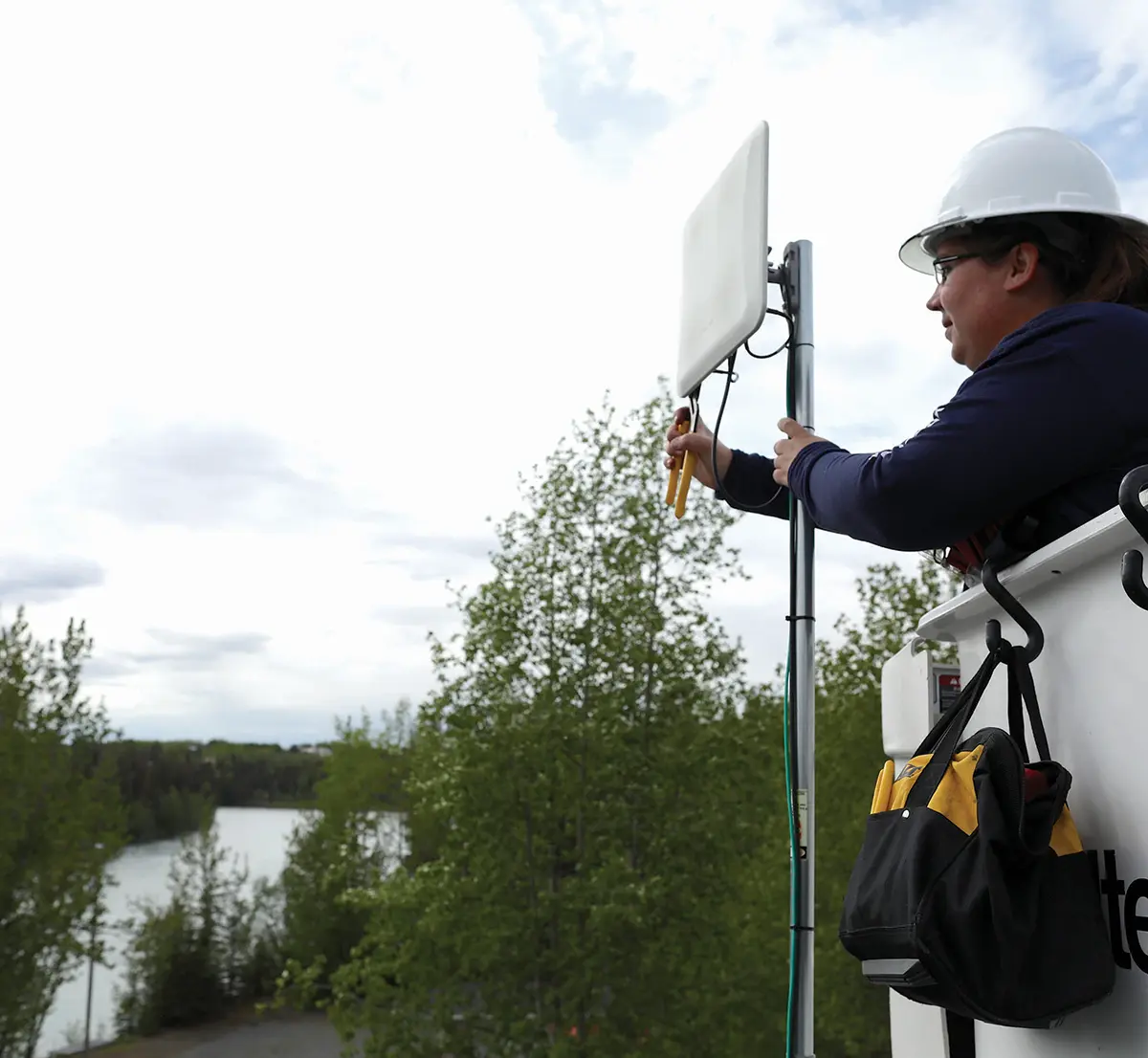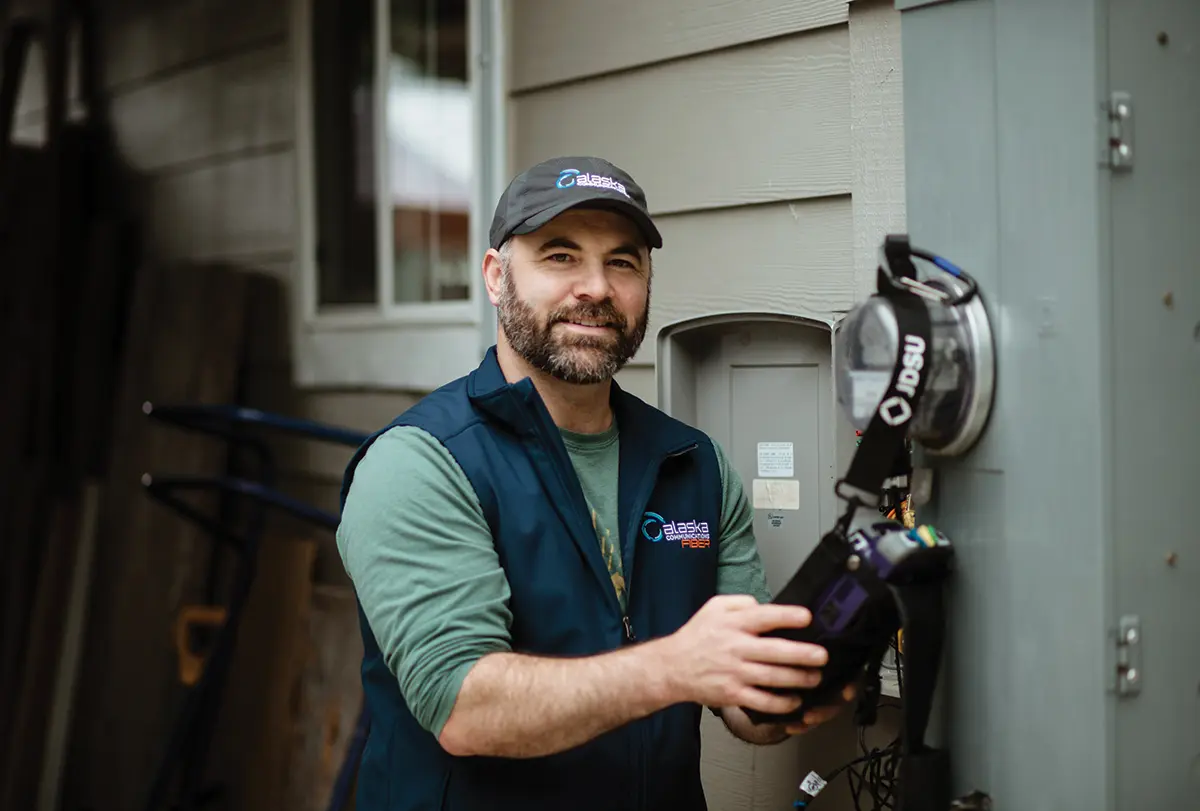
ook closely at a phone bill; there’s a tax added for the Universal Service Fund (USF). The Federal Communications Commission (FCC) manages the USF to bolster projects aimed at expanding and improving broadband and cellular communication. Normally, providers must meet strict standards to receive funds from the USF. But things aren’t that simple in Alaska, which is why the FCC created a special order for Alaska providers, aptly called the Alaska Plan.
“Alaska just does not have the infrastructure that they have in the Lower 48… It’s a balance of how much money you have and how good a service can you provide, and just that mix in Alaska is different,” says Christine O’Connor, executive director of Alaska Telecom Association (ATA). “So they allowed the opportunity to adjust what those obligations are based on the realities on the ground.”
The Alaska Plan has allowed the expansion of broadband and telephone services for tens of thousands of people in Alaska. It is set to expire in 2026, but industry officials are hoping to extend it and continue the benefits to Alaska.
O’Connor says, “When you think of the modern economy, or anything you’re trying to do now, you almost can’t do it without broadband. You know, applying for your jobs, pay your bills.”
Americans rely on broadband and telephone service in everyday life: sending emails at work, researching a school assignment, talking to distant relatives, paying bills, and making plans for Friday night.
According to the FCC, “Broadband has gone from being a luxury to a necessity for full participation in our economy and society—for all Americans.”
The FCC estimates between 14 million and 24 million Americans do not have internet access. Around one-third of those don’t have broadband because they can’t afford it.
In Alaska, the number of people without service is staggering. Most rural communities, which encompasses 60,000 people, do not have any broadband service. On top of that, an additional 200,000 people have broadband, but their services do not meet the minimum federal standards, according to Alaska Broadband Workforce Development.
With more than one-third of the state being underserved, there is a real need for broadband and telecom improvement.
“[Rural and remote] areas of Alaska are some of the hardest to serve in the country, where many residents lack access to high-quality affordable broadband and the opportunity to keep up with the advances in technology that Americans living elsewhere enjoy,” a 2023 report from the FCC states.
One of the core missions of the FCC is to provide universal telephone and broadband service to the entirety of the United States. Per the Telecommunications Act of 1996, telecommunications companies are required to contribute to the USF. The amount of money that they need to contribute is determined on a quarterly basis, based around the number of projects the USF is funding.
“That’s where the Alaska Plan and the larger universal service program comes in. It’s critical to making that happen,” says O’Connor.
The fund is distributed in a number of ways. There is a Lifeline fund for low-income individuals and residents of tribal lands, a Rural Health Care fund, the Schools and Libraries e-rate, and the Connect America Fund, which supports rural areas.
Because of the unique environment of Alaska, there is a distinct plan for Alaska telecommunication providers.
“It’s very expensive. It’s usually in rural Alaska serving a small population, they’re trying to puzzle together all the resources that are needed when often an area is not quite big enough to support the infrastructure you need,” O’Connor says. “Then you have the technology challenges, the geography, the climate, all of this. The normal things in remote Alaska that everyone has to manage.”
Thirteen of the fifteen carriers in Alaska opted to join the Alaska Plan. They receive a yearly fixed rate of money from the USF. This money can go toward a number of things, including lowering rate costs and investing in improved infrastructure.

Alaska Communications

Alaska Communications is one of the carriers that participates in the Alaska Plan.
“High-cost support is critical to closing the digital divide in Alaska, continuing to increase internet speeds, and keeping internet affordable. Alaska Communications is strongly in favor of programs that offset the cost of broadband expansion,” Alaska Communications’ Vice President of External Affairs and Corporate Communications Heather Cavanaugh says. “Our goal is to continue serving as many Alaskans as possible, to improve access to education, healthcare, and economic opportunities and overall quality of life.”
With the support of the Alaska Plan, Alaska Communications has improved service to clients in Anchor Point, Coffman Cove, Delta Junction, Kasilof, Klawock, Larsen Bay, Nenana, Nikiski, Ninilchik, North Pole, Salcha, Seldovia, Soldotna, Sterling, and Thorne Bay, according to Cavanaugh. This has improved service for around 30,000 customers.
MTA is also in the Alaska Plan. The company services 34,000 customers across 10,000 square miles of the Matanuska-Susitna Borough and Chugiak-Eagle River (almost the size of the state of Maryland), according to CEO Michael Burke. It received $248 million to build new infrastructure and update services for more than 31,000 of its customers.
“The Alaska Plan (now called the Alaska Connect Fund) addresses the unique challenges of providing broadband in Alaska, including its vast geography and remote locations, ensuring that Alaskans are not left behind in the digital age,” Burke writes in an email.
In total, more than 88,000 locations have benefitted from the Alaska Plan as of December 2022, according to a 2023 FCC report. The FCC estimates it has increased the number of Alaskans with 4G LTE from a little more than 33,000 in 2016 to more than 85,000 in that time.
One of the most impactful projects was the construction of more “middle miles,” or connections between communities, according to O’Connor.
There are still 70,000 Alaskans without access to the FCC’s minimum broadband standards, according to the 2023 FCC report.
“In recognition of the unique challenges of Alaska, in the following, the [Federal Communications] Commission seeks comment on how to define unserved and, if needed, underserved for the purposes of this next phase for support in Alaska,” the FCC’s most recent Proposed Rule about the future of the Alaska Plan states.
If the Alaska Plan were to continue beyond its 2026 sunset date or be succeeded by the Alaska Connect Fund or another alternative, O’Connor believes that the momentum that started in 2016 will continue.
“Every company is a little bit different in what they’re working on, what they’re able to do,” O’Connor says. “I expect that all the providers will end up going back to the FCC, like the first time, and saying, ‘Here’s what we are going to accomplish. Here’s what this level of funding will let us do.’”
“Right now the program ends at the end of 2026, which, when you’re thinking about infrastructure planning and deployment, that’s like tomorrow,” O’Connor says. “I do not expect that to happen; I just say the consequences of that would be really extreme.”
Expiration of the Alaska Plan would effectively stop new infrastructure projects. Both Cavanaugh and Burke agree that if the plan were to end, people across the state would suffer.
The FCC is deliberating how to continue to support broadband development in the state after the Alaska Plan lapses. It is planning on creating the Alaska Connect Fund, which would also support telecommunication and broadband development in the state. There are several things that need to be taken into consideration before the completion of this plan, including what services are eligible for support from the ACF and how it would fit in with other programs the FCC runs throughout the country.
ATA petitioned the FCC to extend the Alaska Connect Fund until 2034, which would put it on the same timeline as broadband programs in the Lower 48, according to O’Connor.
“The [Infrastructure Investments and Jobs Act]… very much needs to run in coordination with the Alaska Plan and with the USDA’s… ReConnect,” O’Connor says.
The US Department of Agriculture’s ReConnect Loan and Grant Program provides loans, grants, and combinations of the two for projects that will expand and improve broadband services in rural areas. Alaska has been awarded almost $500 million from ReConnect.
“The main reason companies are able to apply for and get those grants is because they had the Alaska Plan and the certainty it provided,” O’Conner says. “There’s just this… really positive alignment of these programs happening.”